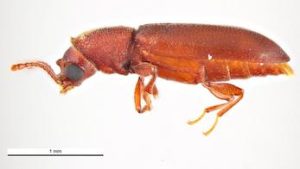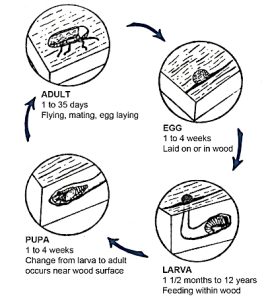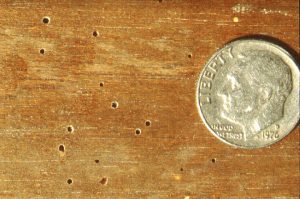Powderpost Beetles: Turning Furniture into Pulp
By Catherine Macaulay, Fairfax Master Gardener Intern
 Last week, my friend and I walked the banks of the Potomac River, hunting for driftwood and fallen boughs for our Japanese Ikebana flower arrangements. We were in luck and netted ourselves multiple branches, some beautifully curved and knotted. “You might wish to keep your pieces outdoors for awhile,” advised my friend. “We want to be sure and give any potential bugs inside enough time to relocate.”
Last week, my friend and I walked the banks of the Potomac River, hunting for driftwood and fallen boughs for our Japanese Ikebana flower arrangements. We were in luck and netted ourselves multiple branches, some beautifully curved and knotted. “You might wish to keep your pieces outdoors for awhile,” advised my friend. “We want to be sure and give any potential bugs inside enough time to relocate.”
The very notion made me cringe. I hadn’t imagined any hitchhikers carving their homes in my well-seasoned finds. While stories about community mulch piles potentially harboring insects are always in circulation, what danger could a bit of dead wood pose?
Enter Powderpost beetles, small, wood-boring insects capable of reducing wood to powder. They are considered the most destructive, second only to termites, in their ability to damage dry, seasoned wood. The term “Powderpost” is used to describe any of approximately 70 wood-boring species of beetles from the insect order Coleoptera.
Generally less than one-fourth inch in length (6 mm), these little pests can be found primarily in hardwoods, including flooring, paneling and window and door frames. Some Powderpost species will also infest the softwood of studs, joists and beams in your home. Old furniture and wood antiques are especially vulnerable to their attack.
It’s difficult to know exactly where these undesirables come from. Powderpost beetles can relocate without ever leaving home just by snagging a ride on a shipment of wood being transported from one location to another. Generally, they enter lumber when it’s being stored and cured, emerging later from the finished product.

Powderpost beetle life cycle
Life History
Ranging from reddish-brown to nearly black in color, these havoc-wrecking insects have four distinct life stages: egg, larva, pupa and adult. It is the larval stage that’s largely responsible for much of the actual damage to the wood.
Once the adult beetles have laid their eggs inside the pores of the wood, they exit through a small, round hole about one-sixteenth inch to one-eighth inch in diameter (1 – 3mm). They usually emerge in the spring, leaving behind creamy white, C-shaped larvae hungry for food.
Depending upon the wood and the particular species of beetle, these larvae can feed anywhere from a few months to several years, their boring behaviors resulting in a sawdust-like powder, the byproduct of their channeling.

Lyctid powderpost beetle damage
Management and Treatment
Discovering bullet-size holes and ultra-fine deposits of wood in and around your treasured antiques or worse, inside the beams of your house, can be disconcerting. Fortunately, the Powderpost beetle isn’t too swift and generally takes its time to work into a full infestation. Some colonies can die out of their own accord.
While controlling an infestation is best addressed by a professional pest control operator, Virginia Tech outlines some basic application methods for homeowners, purely as background information. These methods include:
Surface treatment — applying an insecticide to an unfinished wood surface, coating the emergence holes where wood dust is seen. This application method will kill the adult beetles and penetrate the wood to some degree, helping kill the larvae inside.
Injection treatment — applying an insecticide directly into the wood. This application method is targeted toward killing the larvae and deterring re-infestation for several years.
Sifting through any formulation of insecticides can be daunting. Virginia Tech’s Pest Management Guide recommends disodium octaborate and tetrahydrate, among others. Whatever your poison or source, it’s important to read and carefully follow the instructions on the product label. Contact your local Extension agent, the VDACS pesticide investigator, or pesticide dealer with any questions, or for the latest information on any pesticide label changes.
When selecting a pest exterminator, don’t hesitate to pose questions. How have they properly identified your beetle infestation? Are the holes fresh or are they the remains of an old feeding cycle? To prevent the Powderpost beetle from breeding in your wood, it’s crucial to identify the infestation and treat it accordingly.
From now on, any Ikebana finds that I have will be duly sanded and varnished before making it through this front door. I want a hard, smooth surface that offers zero cracks and crevices for the beetle to penetrate. It’s not that I’m running scared, but merely erring on the side of caution. Not an altogether bad attitude when dealing with the Powderpost beetle.
Resources
• Powderpost Beetles: Nuisance Insects in the House and Yard, Wood Destroying Insects, Dini M. Miller,
2021 Pest Management Guide, Virginia Cooperative Extension, Table 2, pages 6-5 and 6-6
• Powderpost Beetles, Steve Jacobs, PennState Extension
• Powderpost Beetles, Michael F. Potter, University of Kentucky College of Agriculture
• Household and Structural Powderpost Beetles, Gary W. Bennett, Purdue University Extension